Social Innovation Assignment Solution
VerifiedAdded on 2021/06/17
|10
|2803
|20
AI Summary
Contribute Materials
Your contribution can guide someone’s learning journey. Share your
documents today.
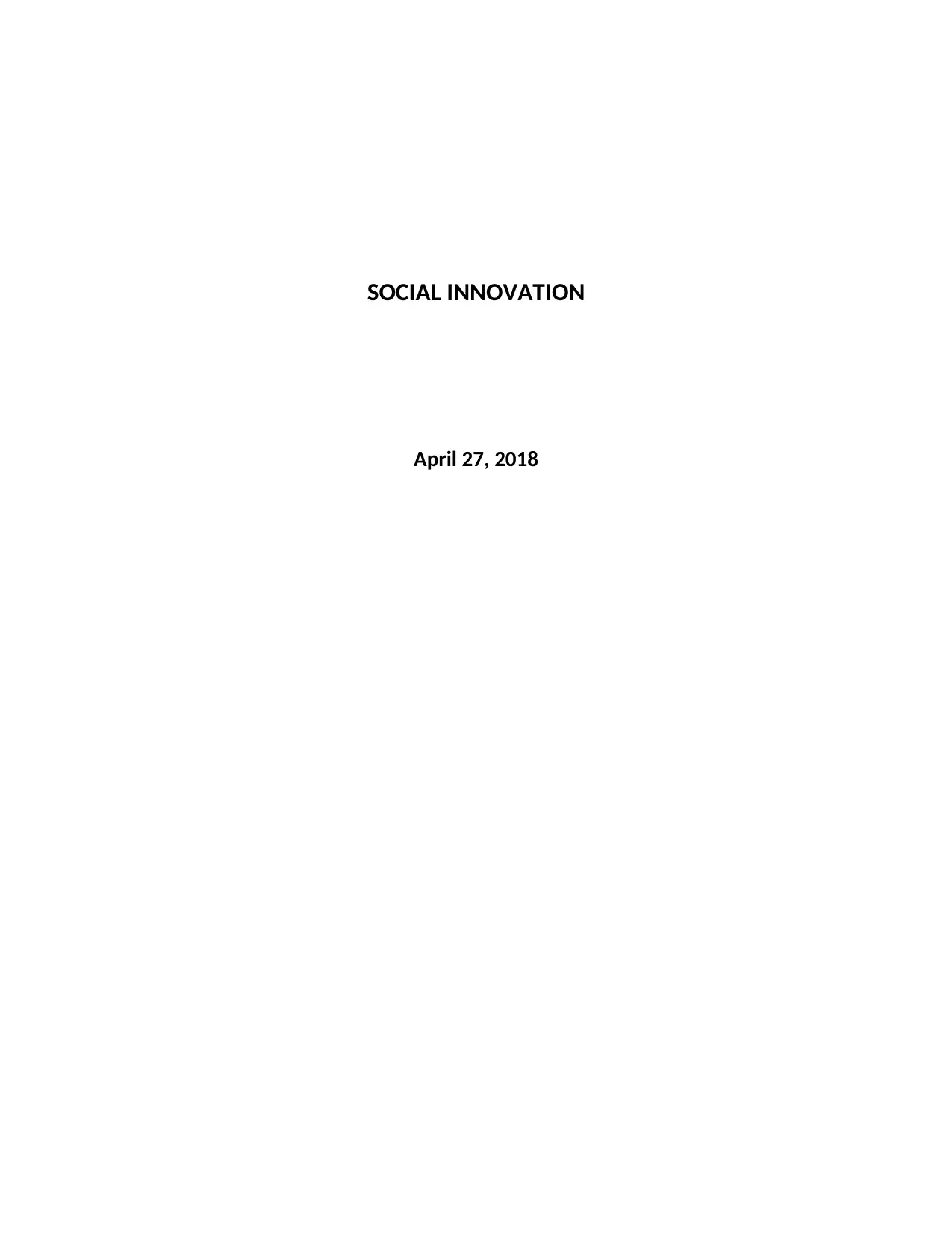
SOCIAL INNOVATION
April 27, 2018
April 27, 2018
Secure Best Marks with AI Grader
Need help grading? Try our AI Grader for instant feedback on your assignments.
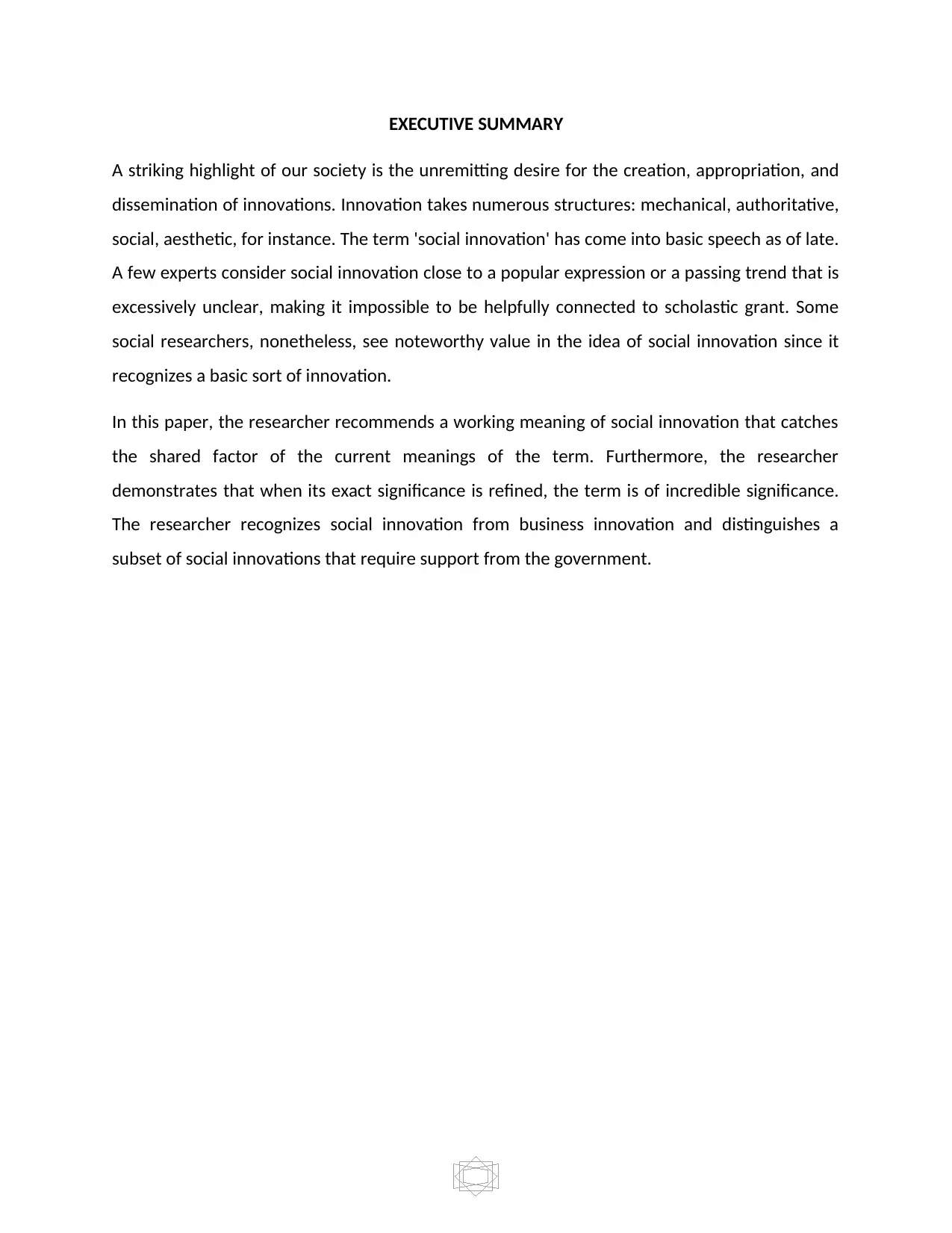
EXECUTIVE SUMMARY
A striking highlight of our society is the unremitting desire for the creation, appropriation, and
dissemination of innovations. Innovation takes numerous structures: mechanical, authoritative,
social, aesthetic, for instance. The term 'social innovation' has come into basic speech as of late.
A few experts consider social innovation close to a popular expression or a passing trend that is
excessively unclear, making it impossible to be helpfully connected to scholastic grant. Some
social researchers, nonetheless, see noteworthy value in the idea of social innovation since it
recognizes a basic sort of innovation.
In this paper, the researcher recommends a working meaning of social innovation that catches
the shared factor of the current meanings of the term. Furthermore, the researcher
demonstrates that when its exact significance is refined, the term is of incredible significance.
The researcher recognizes social innovation from business innovation and distinguishes a
subset of social innovations that require support from the government.
A striking highlight of our society is the unremitting desire for the creation, appropriation, and
dissemination of innovations. Innovation takes numerous structures: mechanical, authoritative,
social, aesthetic, for instance. The term 'social innovation' has come into basic speech as of late.
A few experts consider social innovation close to a popular expression or a passing trend that is
excessively unclear, making it impossible to be helpfully connected to scholastic grant. Some
social researchers, nonetheless, see noteworthy value in the idea of social innovation since it
recognizes a basic sort of innovation.
In this paper, the researcher recommends a working meaning of social innovation that catches
the shared factor of the current meanings of the term. Furthermore, the researcher
demonstrates that when its exact significance is refined, the term is of incredible significance.
The researcher recognizes social innovation from business innovation and distinguishes a
subset of social innovations that require support from the government.
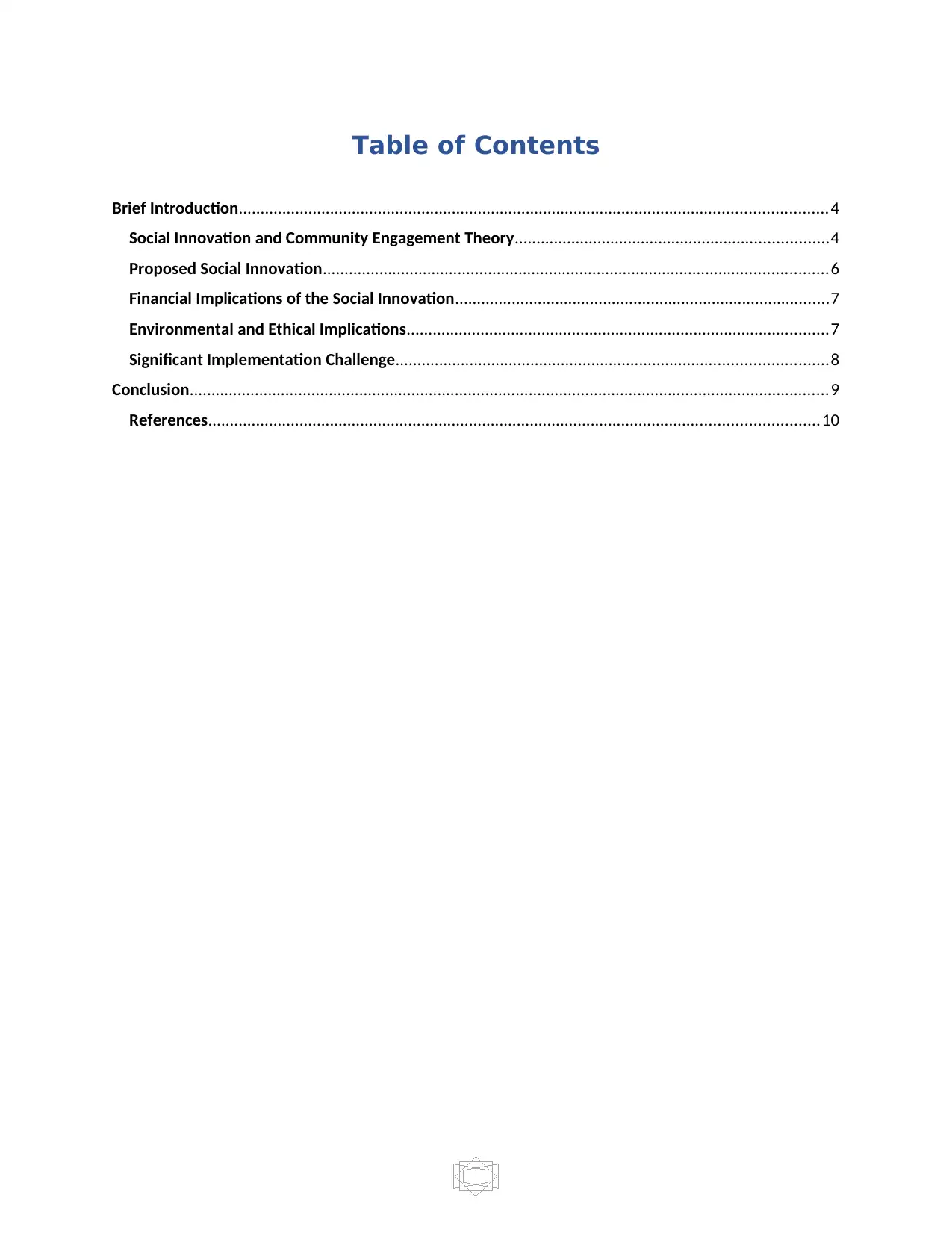
Table of Contents
Brief Introduction.......................................................................................................................................4
Social Innovation and Community Engagement Theory........................................................................4
Proposed Social Innovation....................................................................................................................6
Financial Implications of the Social Innovation......................................................................................7
Environmental and Ethical Implications.................................................................................................7
Significant Implementation Challenge...................................................................................................8
Conclusion...................................................................................................................................................9
References............................................................................................................................................10
Brief Introduction.......................................................................................................................................4
Social Innovation and Community Engagement Theory........................................................................4
Proposed Social Innovation....................................................................................................................6
Financial Implications of the Social Innovation......................................................................................7
Environmental and Ethical Implications.................................................................................................7
Significant Implementation Challenge...................................................................................................8
Conclusion...................................................................................................................................................9
References............................................................................................................................................10
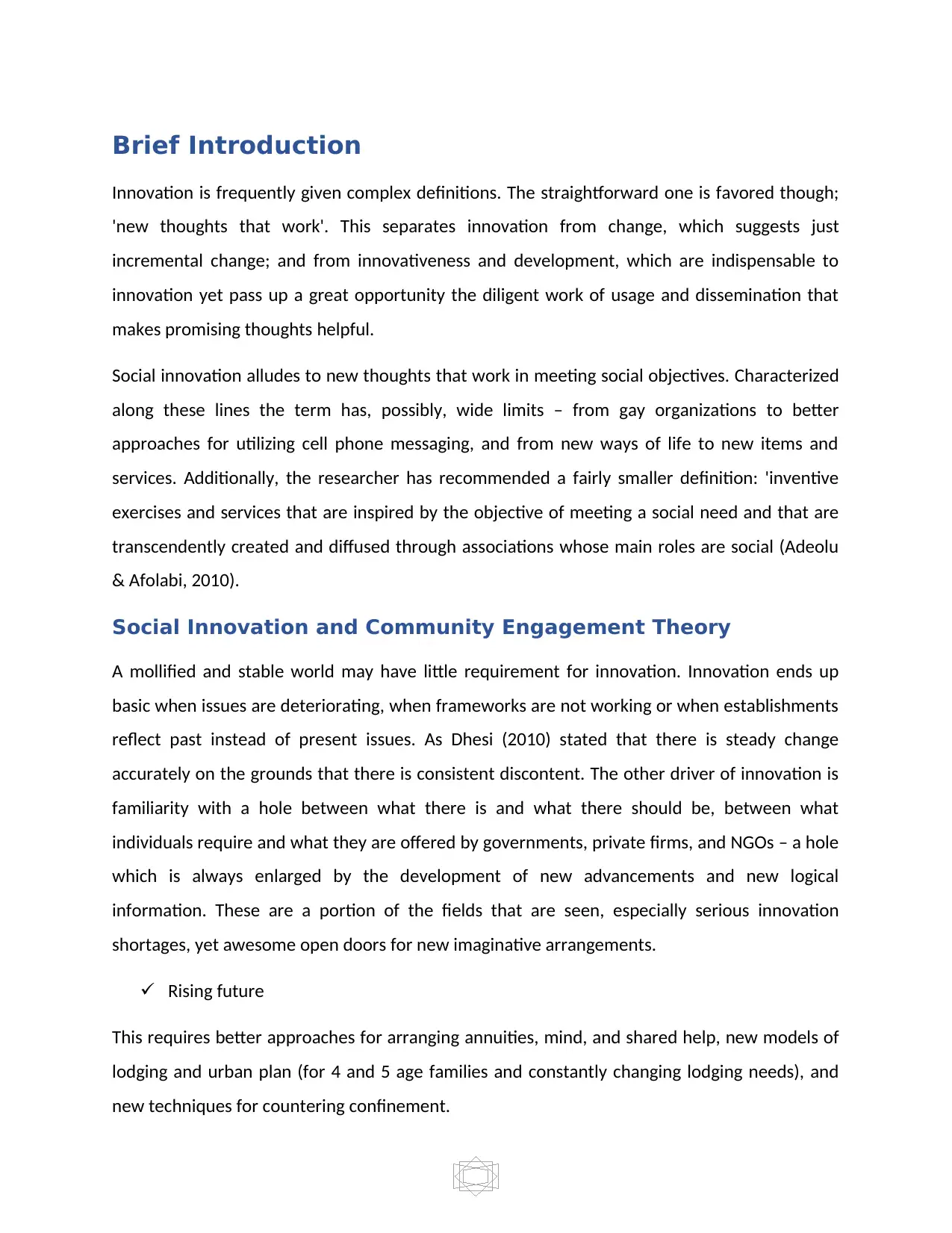
Brief Introduction
Innovation is frequently given complex definitions. The straightforward one is favored though;
'new thoughts that work'. This separates innovation from change, which suggests just
incremental change; and from innovativeness and development, which are indispensable to
innovation yet pass up a great opportunity the diligent work of usage and dissemination that
makes promising thoughts helpful.
Social innovation alludes to new thoughts that work in meeting social objectives. Characterized
along these lines the term has, possibly, wide limits – from gay organizations to better
approaches for utilizing cell phone messaging, and from new ways of life to new items and
services. Additionally, the researcher has recommended a fairly smaller definition: 'inventive
exercises and services that are inspired by the objective of meeting a social need and that are
transcendently created and diffused through associations whose main roles are social (Adeolu
& Afolabi, 2010).
Social Innovation and Community Engagement Theory
A mollified and stable world may have little requirement for innovation. Innovation ends up
basic when issues are deteriorating, when frameworks are not working or when establishments
reflect past instead of present issues. As Dhesi (2010) stated that there is steady change
accurately on the grounds that there is consistent discontent. The other driver of innovation is
familiarity with a hole between what there is and what there should be, between what
individuals require and what they are offered by governments, private firms, and NGOs – a hole
which is always enlarged by the development of new advancements and new logical
information. These are a portion of the fields that are seen, especially serious innovation
shortages, yet awesome open doors for new imaginative arrangements.
Rising future
This requires better approaches for arranging annuities, mind, and shared help, new models of
lodging and urban plan (for 4 and 5 age families and constantly changing lodging needs), and
new techniques for countering confinement.
Innovation is frequently given complex definitions. The straightforward one is favored though;
'new thoughts that work'. This separates innovation from change, which suggests just
incremental change; and from innovativeness and development, which are indispensable to
innovation yet pass up a great opportunity the diligent work of usage and dissemination that
makes promising thoughts helpful.
Social innovation alludes to new thoughts that work in meeting social objectives. Characterized
along these lines the term has, possibly, wide limits – from gay organizations to better
approaches for utilizing cell phone messaging, and from new ways of life to new items and
services. Additionally, the researcher has recommended a fairly smaller definition: 'inventive
exercises and services that are inspired by the objective of meeting a social need and that are
transcendently created and diffused through associations whose main roles are social (Adeolu
& Afolabi, 2010).
Social Innovation and Community Engagement Theory
A mollified and stable world may have little requirement for innovation. Innovation ends up
basic when issues are deteriorating, when frameworks are not working or when establishments
reflect past instead of present issues. As Dhesi (2010) stated that there is steady change
accurately on the grounds that there is consistent discontent. The other driver of innovation is
familiarity with a hole between what there is and what there should be, between what
individuals require and what they are offered by governments, private firms, and NGOs – a hole
which is always enlarged by the development of new advancements and new logical
information. These are a portion of the fields that are seen, especially serious innovation
shortages, yet awesome open doors for new imaginative arrangements.
Rising future
This requires better approaches for arranging annuities, mind, and shared help, new models of
lodging and urban plan (for 4 and 5 age families and constantly changing lodging needs), and
new techniques for countering confinement.
Secure Best Marks with AI Grader
Need help grading? Try our AI Grader for instant feedback on your assignments.
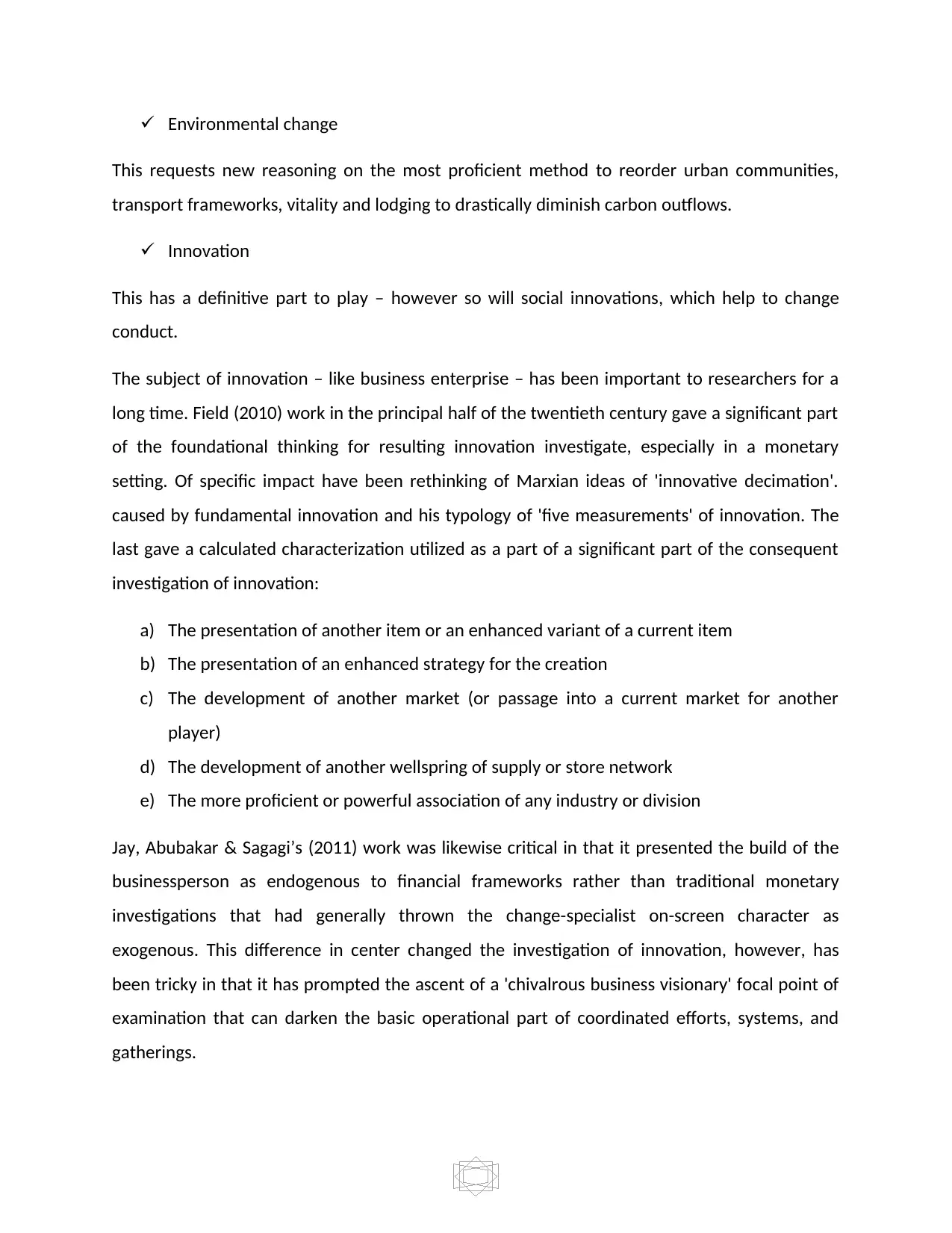
Environmental change
This requests new reasoning on the most proficient method to reorder urban communities,
transport frameworks, vitality and lodging to drastically diminish carbon outflows.
Innovation
This has a definitive part to play – however so will social innovations, which help to change
conduct.
The subject of innovation – like business enterprise – has been important to researchers for a
long time. Field (2010) work in the principal half of the twentieth century gave a significant part
of the foundational thinking for resulting innovation investigate, especially in a monetary
setting. Of specific impact have been rethinking of Marxian ideas of 'innovative decimation'.
caused by fundamental innovation and his typology of 'five measurements' of innovation. The
last gave a calculated characterization utilized as a part of a significant part of the consequent
investigation of innovation:
a) The presentation of another item or an enhanced variant of a current item
b) The presentation of an enhanced strategy for the creation
c) The development of another market (or passage into a current market for another
player)
d) The development of another wellspring of supply or store network
e) The more proficient or powerful association of any industry or division
Jay, Abubakar & Sagagi’s (2011) work was likewise critical in that it presented the build of the
businessperson as endogenous to financial frameworks rather than traditional monetary
investigations that had generally thrown the change-specialist on-screen character as
exogenous. This difference in center changed the investigation of innovation, however, has
been tricky in that it has prompted the ascent of a 'chivalrous business visionary' focal point of
examination that can darken the basic operational part of coordinated efforts, systems, and
gatherings.
This requests new reasoning on the most proficient method to reorder urban communities,
transport frameworks, vitality and lodging to drastically diminish carbon outflows.
Innovation
This has a definitive part to play – however so will social innovations, which help to change
conduct.
The subject of innovation – like business enterprise – has been important to researchers for a
long time. Field (2010) work in the principal half of the twentieth century gave a significant part
of the foundational thinking for resulting innovation investigate, especially in a monetary
setting. Of specific impact have been rethinking of Marxian ideas of 'innovative decimation'.
caused by fundamental innovation and his typology of 'five measurements' of innovation. The
last gave a calculated characterization utilized as a part of a significant part of the consequent
investigation of innovation:
a) The presentation of another item or an enhanced variant of a current item
b) The presentation of an enhanced strategy for the creation
c) The development of another market (or passage into a current market for another
player)
d) The development of another wellspring of supply or store network
e) The more proficient or powerful association of any industry or division
Jay, Abubakar & Sagagi’s (2011) work was likewise critical in that it presented the build of the
businessperson as endogenous to financial frameworks rather than traditional monetary
investigations that had generally thrown the change-specialist on-screen character as
exogenous. This difference in center changed the investigation of innovation, however, has
been tricky in that it has prompted the ascent of a 'chivalrous business visionary' focal point of
examination that can darken the basic operational part of coordinated efforts, systems, and
gatherings.
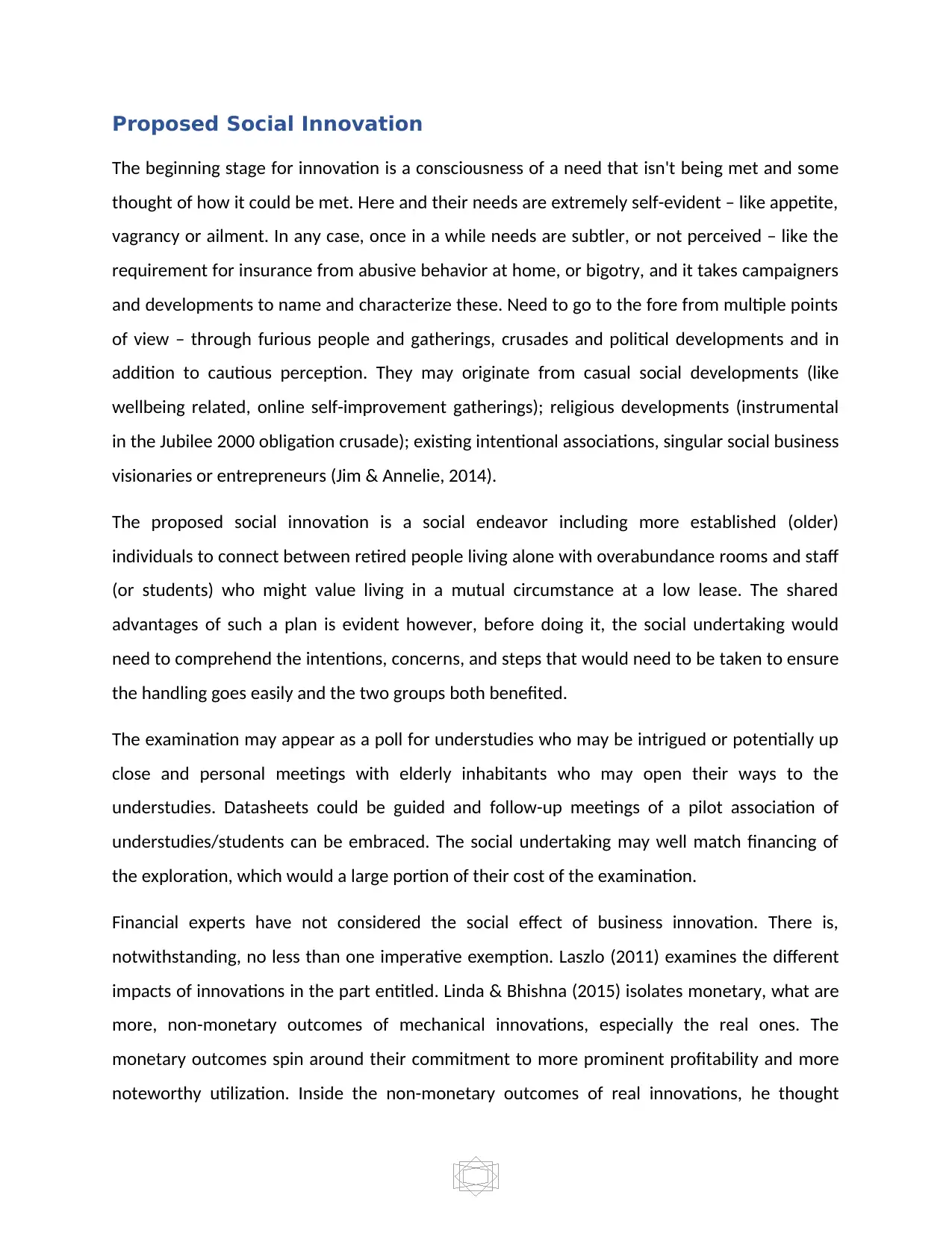
Proposed Social Innovation
The beginning stage for innovation is a consciousness of a need that isn't being met and some
thought of how it could be met. Here and their needs are extremely self-evident – like appetite,
vagrancy or ailment. In any case, once in a while needs are subtler, or not perceived – like the
requirement for insurance from abusive behavior at home, or bigotry, and it takes campaigners
and developments to name and characterize these. Need to go to the fore from multiple points
of view – through furious people and gatherings, crusades and political developments and in
addition to cautious perception. They may originate from casual social developments (like
wellbeing related, online self-improvement gatherings); religious developments (instrumental
in the Jubilee 2000 obligation crusade); existing intentional associations, singular social business
visionaries or entrepreneurs (Jim & Annelie, 2014).
The proposed social innovation is a social endeavor including more established (older)
individuals to connect between retired people living alone with overabundance rooms and staff
(or students) who might value living in a mutual circumstance at a low lease. The shared
advantages of such a plan is evident however, before doing it, the social undertaking would
need to comprehend the intentions, concerns, and steps that would need to be taken to ensure
the handling goes easily and the two groups both benefited.
The examination may appear as a poll for understudies who may be intrigued or potentially up
close and personal meetings with elderly inhabitants who may open their ways to the
understudies. Datasheets could be guided and follow-up meetings of a pilot association of
understudies/students can be embraced. The social undertaking may well match financing of
the exploration, which would a large portion of their cost of the examination.
Financial experts have not considered the social effect of business innovation. There is,
notwithstanding, no less than one imperative exemption. Laszlo (2011) examines the different
impacts of innovations in the part entitled. Linda & Bhishna (2015) isolates monetary, what are
more, non-monetary outcomes of mechanical innovations, especially the real ones. The
monetary outcomes spin around their commitment to more prominent profitability and more
noteworthy utilization. Inside the non-monetary outcomes of real innovations, he thought
The beginning stage for innovation is a consciousness of a need that isn't being met and some
thought of how it could be met. Here and their needs are extremely self-evident – like appetite,
vagrancy or ailment. In any case, once in a while needs are subtler, or not perceived – like the
requirement for insurance from abusive behavior at home, or bigotry, and it takes campaigners
and developments to name and characterize these. Need to go to the fore from multiple points
of view – through furious people and gatherings, crusades and political developments and in
addition to cautious perception. They may originate from casual social developments (like
wellbeing related, online self-improvement gatherings); religious developments (instrumental
in the Jubilee 2000 obligation crusade); existing intentional associations, singular social business
visionaries or entrepreneurs (Jim & Annelie, 2014).
The proposed social innovation is a social endeavor including more established (older)
individuals to connect between retired people living alone with overabundance rooms and staff
(or students) who might value living in a mutual circumstance at a low lease. The shared
advantages of such a plan is evident however, before doing it, the social undertaking would
need to comprehend the intentions, concerns, and steps that would need to be taken to ensure
the handling goes easily and the two groups both benefited.
The examination may appear as a poll for understudies who may be intrigued or potentially up
close and personal meetings with elderly inhabitants who may open their ways to the
understudies. Datasheets could be guided and follow-up meetings of a pilot association of
understudies/students can be embraced. The social undertaking may well match financing of
the exploration, which would a large portion of their cost of the examination.
Financial experts have not considered the social effect of business innovation. There is,
notwithstanding, no less than one imperative exemption. Laszlo (2011) examines the different
impacts of innovations in the part entitled. Linda & Bhishna (2015) isolates monetary, what are
more, non-monetary outcomes of mechanical innovations, especially the real ones. The
monetary outcomes spin around their commitment to more prominent profitability and more
noteworthy utilization. Inside the non-monetary outcomes of real innovations, he thought
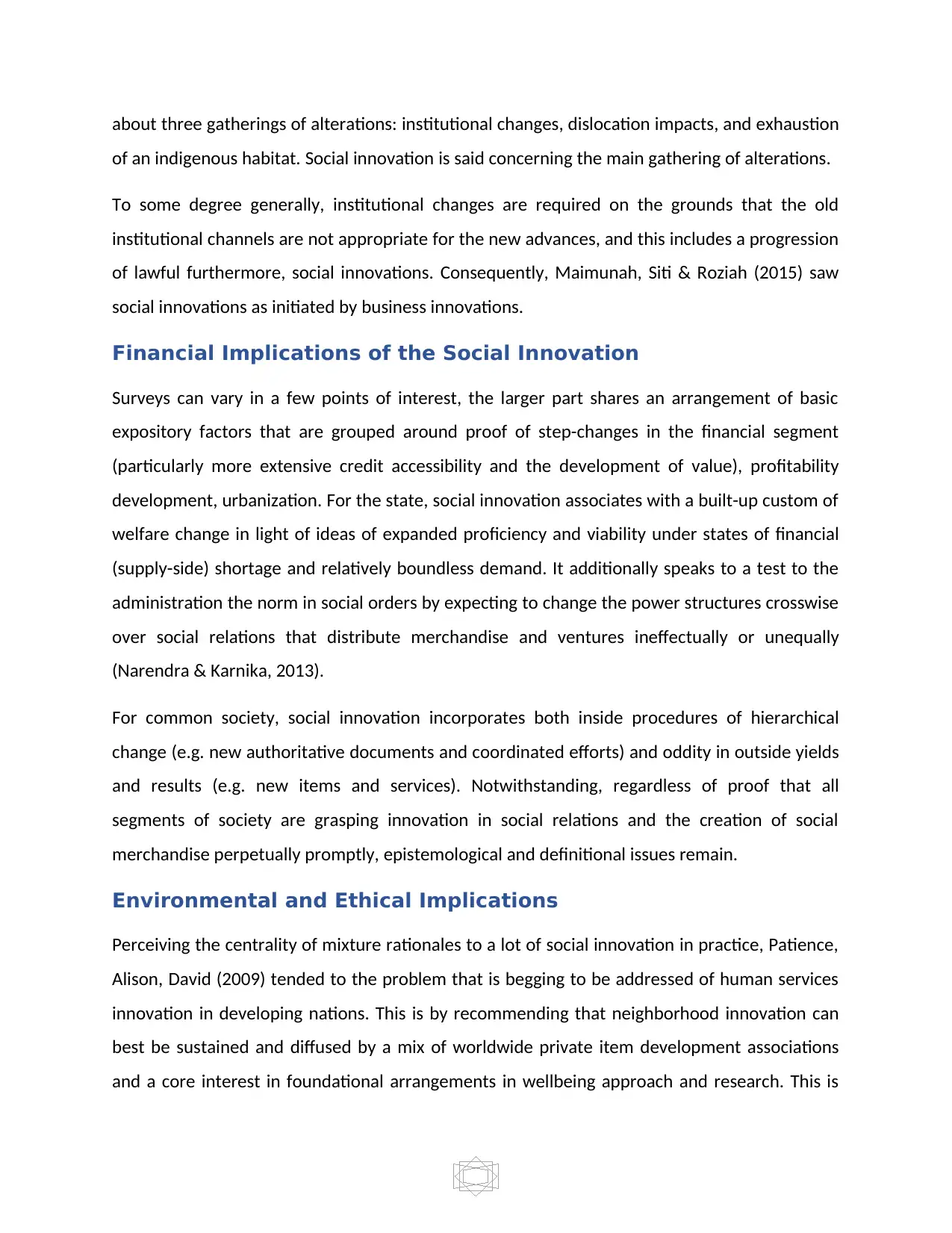
about three gatherings of alterations: institutional changes, dislocation impacts, and exhaustion
of an indigenous habitat. Social innovation is said concerning the main gathering of alterations.
To some degree generally, institutional changes are required on the grounds that the old
institutional channels are not appropriate for the new advances, and this includes a progression
of lawful furthermore, social innovations. Consequently, Maimunah, Siti & Roziah (2015) saw
social innovations as initiated by business innovations.
Financial Implications of the Social Innovation
Surveys can vary in a few points of interest, the larger part shares an arrangement of basic
expository factors that are grouped around proof of step-changes in the financial segment
(particularly more extensive credit accessibility and the development of value), profitability
development, urbanization. For the state, social innovation associates with a built-up custom of
welfare change in light of ideas of expanded proficiency and viability under states of financial
(supply-side) shortage and relatively boundless demand. It additionally speaks to a test to the
administration the norm in social orders by expecting to change the power structures crosswise
over social relations that distribute merchandise and ventures ineffectually or unequally
(Narendra & Karnika, 2013).
For common society, social innovation incorporates both inside procedures of hierarchical
change (e.g. new authoritative documents and coordinated efforts) and oddity in outside yields
and results (e.g. new items and services). Notwithstanding, regardless of proof that all
segments of society are grasping innovation in social relations and the creation of social
merchandise perpetually promptly, epistemological and definitional issues remain.
Environmental and Ethical Implications
Perceiving the centrality of mixture rationales to a lot of social innovation in practice, Patience,
Alison, David (2009) tended to the problem that is begging to be addressed of human services
innovation in developing nations. This is by recommending that neighborhood innovation can
best be sustained and diffused by a mix of worldwide private item development associations
and a core interest in foundational arrangements in wellbeing approach and research. This is
of an indigenous habitat. Social innovation is said concerning the main gathering of alterations.
To some degree generally, institutional changes are required on the grounds that the old
institutional channels are not appropriate for the new advances, and this includes a progression
of lawful furthermore, social innovations. Consequently, Maimunah, Siti & Roziah (2015) saw
social innovations as initiated by business innovations.
Financial Implications of the Social Innovation
Surveys can vary in a few points of interest, the larger part shares an arrangement of basic
expository factors that are grouped around proof of step-changes in the financial segment
(particularly more extensive credit accessibility and the development of value), profitability
development, urbanization. For the state, social innovation associates with a built-up custom of
welfare change in light of ideas of expanded proficiency and viability under states of financial
(supply-side) shortage and relatively boundless demand. It additionally speaks to a test to the
administration the norm in social orders by expecting to change the power structures crosswise
over social relations that distribute merchandise and ventures ineffectually or unequally
(Narendra & Karnika, 2013).
For common society, social innovation incorporates both inside procedures of hierarchical
change (e.g. new authoritative documents and coordinated efforts) and oddity in outside yields
and results (e.g. new items and services). Notwithstanding, regardless of proof that all
segments of society are grasping innovation in social relations and the creation of social
merchandise perpetually promptly, epistemological and definitional issues remain.
Environmental and Ethical Implications
Perceiving the centrality of mixture rationales to a lot of social innovation in practice, Patience,
Alison, David (2009) tended to the problem that is begging to be addressed of human services
innovation in developing nations. This is by recommending that neighborhood innovation can
best be sustained and diffused by a mix of worldwide private item development associations
and a core interest in foundational arrangements in wellbeing approach and research. This is
Paraphrase This Document
Need a fresh take? Get an instant paraphrase of this document with our AI Paraphraser
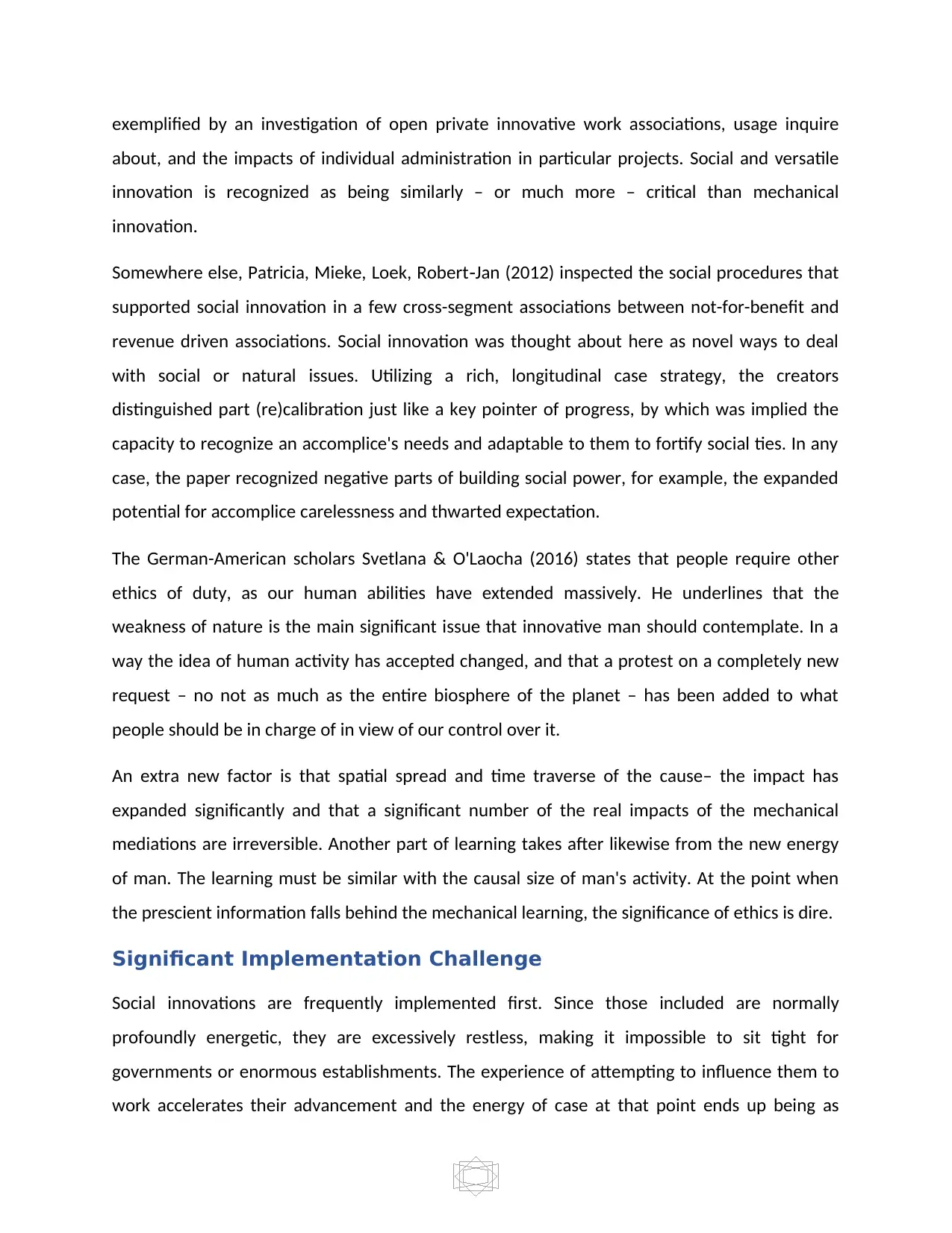
exemplified by an investigation of open private innovative work associations, usage inquire
about, and the impacts of individual administration in particular projects. Social and versatile
innovation is recognized as being similarly – or much more – critical than mechanical
innovation.
Somewhere else, Patricia, Mieke, Loek, Robert Jan (2012) inspected the social procedures that‐
supported social innovation in a few cross-segment associations between not-for-benefit and
revenue driven associations. Social innovation was thought about here as novel ways to deal
with social or natural issues. Utilizing a rich, longitudinal case strategy, the creators
distinguished part (re)calibration just like a key pointer of progress, by which was implied the
capacity to recognize an accomplice's needs and adaptable to them to fortify social ties. In any
case, the paper recognized negative parts of building social power, for example, the expanded
potential for accomplice carelessness and thwarted expectation.
The German-American scholars Svetlana & O'Laocha (2016) states that people require other
ethics of duty, as our human abilities have extended massively. He underlines that the
weakness of nature is the main significant issue that innovative man should contemplate. In a
way the idea of human activity has accepted changed, and that a protest on a completely new
request – no not as much as the entire biosphere of the planet – has been added to what
people should be in charge of in view of our control over it.
An extra new factor is that spatial spread and time traverse of the cause– the impact has
expanded significantly and that a significant number of the real impacts of the mechanical
mediations are irreversible. Another part of learning takes after likewise from the new energy
of man. The learning must be similar with the causal size of man's activity. At the point when
the prescient information falls behind the mechanical learning, the significance of ethics is dire.
Significant Implementation Challenge
Social innovations are frequently implemented first. Since those included are normally
profoundly energetic, they are excessively restless, making it impossible to sit tight for
governments or enormous establishments. The experience of attempting to influence them to
work accelerates their advancement and the energy of case at that point ends up being as
about, and the impacts of individual administration in particular projects. Social and versatile
innovation is recognized as being similarly – or much more – critical than mechanical
innovation.
Somewhere else, Patricia, Mieke, Loek, Robert Jan (2012) inspected the social procedures that‐
supported social innovation in a few cross-segment associations between not-for-benefit and
revenue driven associations. Social innovation was thought about here as novel ways to deal
with social or natural issues. Utilizing a rich, longitudinal case strategy, the creators
distinguished part (re)calibration just like a key pointer of progress, by which was implied the
capacity to recognize an accomplice's needs and adaptable to them to fortify social ties. In any
case, the paper recognized negative parts of building social power, for example, the expanded
potential for accomplice carelessness and thwarted expectation.
The German-American scholars Svetlana & O'Laocha (2016) states that people require other
ethics of duty, as our human abilities have extended massively. He underlines that the
weakness of nature is the main significant issue that innovative man should contemplate. In a
way the idea of human activity has accepted changed, and that a protest on a completely new
request – no not as much as the entire biosphere of the planet – has been added to what
people should be in charge of in view of our control over it.
An extra new factor is that spatial spread and time traverse of the cause– the impact has
expanded significantly and that a significant number of the real impacts of the mechanical
mediations are irreversible. Another part of learning takes after likewise from the new energy
of man. The learning must be similar with the causal size of man's activity. At the point when
the prescient information falls behind the mechanical learning, the significance of ethics is dire.
Significant Implementation Challenge
Social innovations are frequently implemented first. Since those included are normally
profoundly energetic, they are excessively restless, making it impossible to sit tight for
governments or enormous establishments. The experience of attempting to influence them to
work accelerates their advancement and the energy of case at that point ends up being as
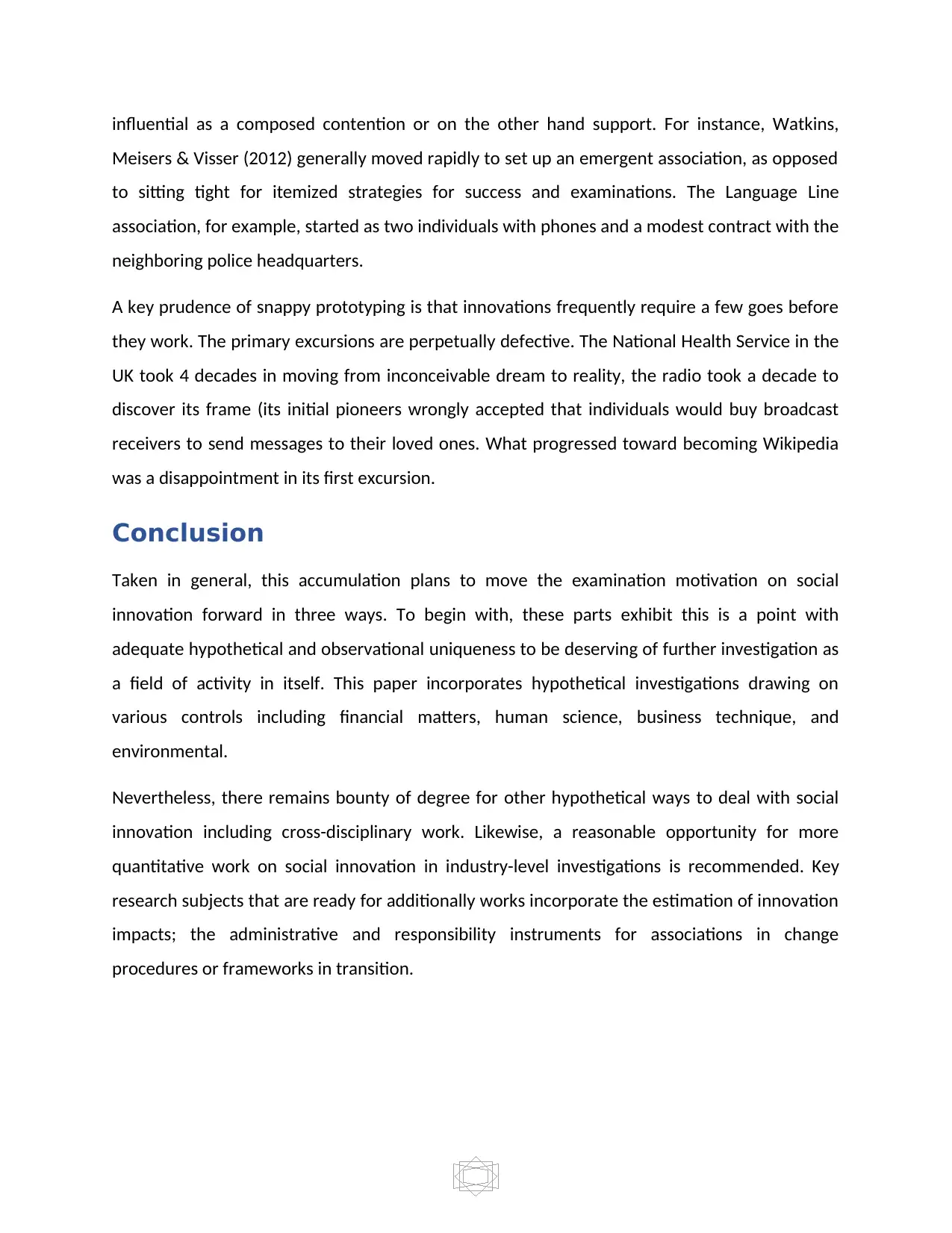
influential as a composed contention or on the other hand support. For instance, Watkins,
Meisers & Visser (2012) generally moved rapidly to set up an emergent association, as opposed
to sitting tight for itemized strategies for success and examinations. The Language Line
association, for example, started as two individuals with phones and a modest contract with the
neighboring police headquarters.
A key prudence of snappy prototyping is that innovations frequently require a few goes before
they work. The primary excursions are perpetually defective. The National Health Service in the
UK took 4 decades in moving from inconceivable dream to reality, the radio took a decade to
discover its frame (its initial pioneers wrongly accepted that individuals would buy broadcast
receivers to send messages to their loved ones. What progressed toward becoming Wikipedia
was a disappointment in its first excursion.
Conclusion
Taken in general, this accumulation plans to move the examination motivation on social
innovation forward in three ways. To begin with, these parts exhibit this is a point with
adequate hypothetical and observational uniqueness to be deserving of further investigation as
a field of activity in itself. This paper incorporates hypothetical investigations drawing on
various controls including financial matters, human science, business technique, and
environmental.
Nevertheless, there remains bounty of degree for other hypothetical ways to deal with social
innovation including cross-disciplinary work. Likewise, a reasonable opportunity for more
quantitative work on social innovation in industry-level investigations is recommended. Key
research subjects that are ready for additionally works incorporate the estimation of innovation
impacts; the administrative and responsibility instruments for associations in change
procedures or frameworks in transition.
Meisers & Visser (2012) generally moved rapidly to set up an emergent association, as opposed
to sitting tight for itemized strategies for success and examinations. The Language Line
association, for example, started as two individuals with phones and a modest contract with the
neighboring police headquarters.
A key prudence of snappy prototyping is that innovations frequently require a few goes before
they work. The primary excursions are perpetually defective. The National Health Service in the
UK took 4 decades in moving from inconceivable dream to reality, the radio took a decade to
discover its frame (its initial pioneers wrongly accepted that individuals would buy broadcast
receivers to send messages to their loved ones. What progressed toward becoming Wikipedia
was a disappointment in its first excursion.
Conclusion
Taken in general, this accumulation plans to move the examination motivation on social
innovation forward in three ways. To begin with, these parts exhibit this is a point with
adequate hypothetical and observational uniqueness to be deserving of further investigation as
a field of activity in itself. This paper incorporates hypothetical investigations drawing on
various controls including financial matters, human science, business technique, and
environmental.
Nevertheless, there remains bounty of degree for other hypothetical ways to deal with social
innovation including cross-disciplinary work. Likewise, a reasonable opportunity for more
quantitative work on social innovation in industry-level investigations is recommended. Key
research subjects that are ready for additionally works incorporate the estimation of innovation
impacts; the administrative and responsibility instruments for associations in change
procedures or frameworks in transition.
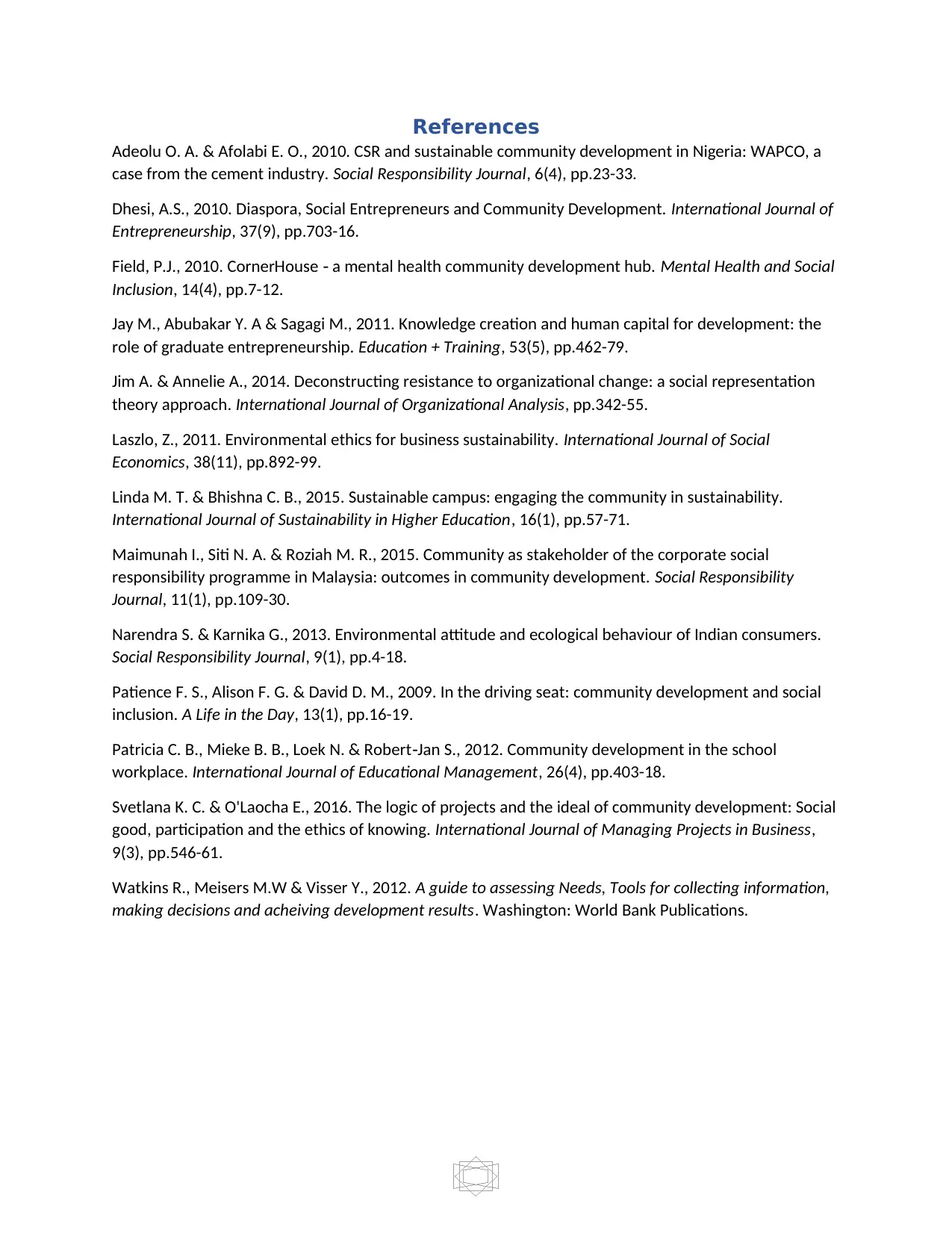
References
Adeolu O. A. & Afolabi E. O., 2010. CSR and sustainable community development in Nigeria: WAPCO, a
case from the cement industry. Social Responsibility Journal, 6(4), pp.23-33.
Dhesi, A.S., 2010. Diaspora, Social Entrepreneurs and Community Development. International Journal of
Entrepreneurship, 37(9), pp.703-16.
Field, P.J., 2010. CornerHouse a mental health community development hub.‐ Mental Health and Social
Inclusion, 14(4), pp.7-12.
Jay M., Abubakar Y. A & Sagagi M., 2011. Knowledge creation and human capital for development: the
role of graduate entrepreneurship. Education + Training, 53(5), pp.462-79.
Jim A. & Annelie A., 2014. Deconstructing resistance to organizational change: a social representation
theory approach. International Journal of Organizational Analysis, pp.342-55.
Laszlo, Z., 2011. Environmental ethics for business sustainability. International Journal of Social
Economics, 38(11), pp.892-99.
Linda M. T. & Bhishna C. B., 2015. Sustainable campus: engaging the community in sustainability.
International Journal of Sustainability in Higher Education, 16(1), pp.57-71.
Maimunah I., Siti N. A. & Roziah M. R., 2015. Community as stakeholder of the corporate social
responsibility programme in Malaysia: outcomes in community development. Social Responsibility
Journal, 11(1), pp.109-30.
Narendra S. & Karnika G., 2013. Environmental attitude and ecological behaviour of Indian consumers.
Social Responsibility Journal, 9(1), pp.4-18.
Patience F. S., Alison F. G. & David D. M., 2009. In the driving seat: community development and social
inclusion. A Life in the Day, 13(1), pp.16-19.
Patricia C. B., Mieke B. B., Loek N. & Robert Jan S., 2012. Community development in the school‐
workplace. International Journal of Educational Management, 26(4), pp.403-18.
Svetlana K. C. & O'Laocha E., 2016. The logic of projects and the ideal of community development: Social
good, participation and the ethics of knowing. International Journal of Managing Projects in Business,
9(3), pp.546-61.
Watkins R., Meisers M.W & Visser Y., 2012. A guide to assessing Needs, Tools for collecting information,
making decisions and acheiving development results. Washington: World Bank Publications.
Adeolu O. A. & Afolabi E. O., 2010. CSR and sustainable community development in Nigeria: WAPCO, a
case from the cement industry. Social Responsibility Journal, 6(4), pp.23-33.
Dhesi, A.S., 2010. Diaspora, Social Entrepreneurs and Community Development. International Journal of
Entrepreneurship, 37(9), pp.703-16.
Field, P.J., 2010. CornerHouse a mental health community development hub.‐ Mental Health and Social
Inclusion, 14(4), pp.7-12.
Jay M., Abubakar Y. A & Sagagi M., 2011. Knowledge creation and human capital for development: the
role of graduate entrepreneurship. Education + Training, 53(5), pp.462-79.
Jim A. & Annelie A., 2014. Deconstructing resistance to organizational change: a social representation
theory approach. International Journal of Organizational Analysis, pp.342-55.
Laszlo, Z., 2011. Environmental ethics for business sustainability. International Journal of Social
Economics, 38(11), pp.892-99.
Linda M. T. & Bhishna C. B., 2015. Sustainable campus: engaging the community in sustainability.
International Journal of Sustainability in Higher Education, 16(1), pp.57-71.
Maimunah I., Siti N. A. & Roziah M. R., 2015. Community as stakeholder of the corporate social
responsibility programme in Malaysia: outcomes in community development. Social Responsibility
Journal, 11(1), pp.109-30.
Narendra S. & Karnika G., 2013. Environmental attitude and ecological behaviour of Indian consumers.
Social Responsibility Journal, 9(1), pp.4-18.
Patience F. S., Alison F. G. & David D. M., 2009. In the driving seat: community development and social
inclusion. A Life in the Day, 13(1), pp.16-19.
Patricia C. B., Mieke B. B., Loek N. & Robert Jan S., 2012. Community development in the school‐
workplace. International Journal of Educational Management, 26(4), pp.403-18.
Svetlana K. C. & O'Laocha E., 2016. The logic of projects and the ideal of community development: Social
good, participation and the ethics of knowing. International Journal of Managing Projects in Business,
9(3), pp.546-61.
Watkins R., Meisers M.W & Visser Y., 2012. A guide to assessing Needs, Tools for collecting information,
making decisions and acheiving development results. Washington: World Bank Publications.
1 out of 10
Related Documents
Your All-in-One AI-Powered Toolkit for Academic Success.
+13062052269
info@desklib.com
Available 24*7 on WhatsApp / Email
![[object Object]](/_next/static/media/star-bottom.7253800d.svg)
Unlock your academic potential
© 2024 | Zucol Services PVT LTD | All rights reserved.





